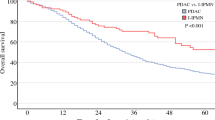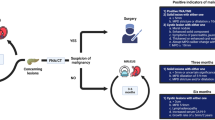Abstract
Pancreatic cancer remains a deadly disease, with few patients surviving 5 years following diagnosis. Surgical resection remains the only treatment associated with the potential for cure; however, most patients have locally advanced or metastatic disease at presentation and thus are not surgical candidates. Advances in imaging technologies, biochemistry, and molecular genetics have raised hopes of improving the outcome for patients with pancreatic cancer through earlier and more accurate diagnosis. As our knowledge of the genetics of pancreatic cancer has increased, the possibility of screening to identify patients at risk to develop the disease also holds promise. This review focuses on the utility of current modalities to screen for pancreatic cancer as well as the most accurate and expedient methods to stage the disease.
Similar content being viewed by others
References and Recommended Reading
American Cancer Society: Cancer statistics 1996. CA Cancer J Clin. 1996, 46:9–16.
Warshaw AL, Castillo CF: Pancreatic carcinoma. N Engl J Med 1992, 326:45–65.
US Preventive Services Task Force: Guide to Clinical Preventive Services. Baltimore: Williams and Wilkins; 1996:67–173.
Ariyama J, Suyama M, Satoh K, Sai J: Imaging of small pancreatic ductal adenocarcinoma. Pancreas. 1998, 16:396–401.
Tanaka S, Kitamura T: Evaluation of routine sonography for early detection of pancreatic cancer. Jpn J Clin Oncol. 1996, 26:422–427.
Flanders TY, Foulkes WD: Pancreatic adenocarcinoma: epidemiology and genetics. J Med Genet. 1996, 33:889–898.
Safi F, Schlosser W, Falkenreck S, Beger HG: Prognostic value of CA 19-9 serum course in pancreatic cancer. Hepatogastroenterology 1998, 45:253–259. Serum expression of CA19-9 was examined in a large cohort of pancreatic cancer patients. Its utility in diagnosis, prognosis, and surveillance is thoroughly analyzed and discussed.
Satake K, Takeuchi T, Homma T, Ozaki H: CA-19-9 as a screening and diagnostic tool in symptomatic patients: the Japanese experience. Pancreas. 1994, 9:703–706.
Satake K, Takeuchi T: Comparison of CA 19-9 with other tumor markers in the diagnosis of cancer of the pancreas. Pancreas. 1994, 9:720–724.
Frebourg T, Bercoff E, Manchon N, et al.: The evaluation of CA 19-9 antigen level in the early detection of pancreatic cancer: a prospective study of 866 patients. Cancer. 1988, 62:2287–2290.
Tokoo M, Oguci H, Kawa S, et al.: Mass survey for pancreatic cancer using measurement of serum markers: a case of resectable pancreatic tail cancer detected. Pancreas. 1990, 5:156–160.
Chari S, Klee CG, Miller LJ, et al.: Sensitivity and specificity of CA 19-9 and islet amyloid polypeptide (IAPP) for symptomatic pancreatic cancer (PC). Pancreas. 1998, 17:429–433.
Nakaizumi A, Tatsuta M, Uehara H, et al.: A prospective trial of early detection of pancreatic cancer by ultrasonographic examination combined with measurement of serum elastase 1. Cancer. 1992, 69:936–940.
Ghadirian P, Baillargeon J, Simard A, Perret C: Food habits and pancreatic cancer: a case control study of the francophone community in Montreal, Canada. Cancer Epidemiol Biomarkers Prev. 1995, 4:895–899.
Gold EB: Epidemiology of and risk factors for pancreatic cancer. Surg Clin North Am. 1995, 75:819–843.
Connolly MM, Dawson PJ, Michelassi F, et al.: Survival in 1001 patients with carcinoma of the pancreas. Ann Surg. 1987, 206:366–373.
Lumadue JA, Griffin CA, Osman M, Hruban RH: Familial pancreatic cancer and the genetics of pancreatic cancer. Surg Clin North Am. 1995, 75:845–855.
Whitcomb DC, Gorry MC, Preston RA, et al.: Hereditary pancreatitis is caused by a mutation in the cationic trypsinogen gene. Nat Genet. 1996,14:141–145.
Lowenfels AB, Maisonneuve P, DiMagno EP, et al.: Hereditary pancreatitis and the risk of pancreatic cancer. J Natl Cancer Inst. 1997, 89:442–446.
Goggins M, Schutte M, Lu J, et al.: Germline BRCA2 gene mutations in patients with apparently sporadic pancreatic carcinomas. Cancer Res. 1996, 56:5360–5364.
Kern SE: Advances from genetic clues in pancreatic cancer. Curr Opin Oncol. 1998, 10:74–80. The author provides an excellent review of the known molecular events associated with pancreatic carcinoma.
Lynch HT: Genetics and pancreatic cancer. Arch Surg. 1994, 129:266–268.
Furuya N, Kawa S, Akamatsu T, Furihata K: Long-term followup of patients with chronic pancreatitis and K-ras gene mutation detected in pancreatic juice. Gastroenterology. 1997, 113:593–598.
Hiyama E, Kodama T, Shinbara K, et al.: Telomerase activity is detected in pancreatic cancer but not in benign tumors. Cancer Res. 1997, 57:326–331. Telomerase activity is demonstrated to be specific to malignant versus benign pancreatic neoplasms. The potential use of this nongenetic assay for early detection of pancreatic cancers is described.
Warshaw AL, Gu Z, Wittenberg J, Waltman AC: Preoperative staging and assessment of resectability of pancreatic cancer. Arch Surg. 1990, 125:230–233.
Cuesta MA, Meijer S, Borgstein PJ, et al.: Laparoscopic ultrasonography for hepatobiliary and pancreatic malignancy. Br J Surg. 1993, 80:1571–1574.
Conlon KC, Dougherty E, Klimstra DS, et al.: The value of minimal access surgery in the staging of patients with potentially resectable peripancreatic malignancy. Ann Surg. 1996, 223:134–140.
Merchant NB, Conlon KC: Laparoscopic evaluation in pancreatic cancer. Semin Surg Oncol. 1998, 15:155–165. The authors provide an overview of the utility of laparoscopic staging for pancreatic cancer.
Willett CG, Lewandrowski K, Warshaw AL, et al.: Resection margins in carcinoma of the head of the pancreas: implications for radiation therapy. Ann Surg. 1993, 217:144–148.
Leach SD, Lee JE, Charnsangavej C, et al.: Survival following pancreaticoduodenectomy with resection of the superior mesenteric-portal vein confluence for adenocarcinoma of the pancreatic head. Br J Surg. 1998, 85:611–617. Data from this study suggest that isolated involvement of the PV-SMV should not represent a contraindication to pancreaticoduodenectomy. The authors present an excellent discussion of the surgical and staging issues relevant to this controversy.
Harrison LE, Klimstra DS, Brennan MF: Isolated portal vein involvement in pancreatic adenocarcinoma: a contraindication for resection? Ann Surg. 1996, 224:342–349.
Brambs HJ, Claussen CD: Pancreatic and ampullary carcinoma: ultrasound, computed tomography, magnetic resonance imaging and angiography. Endoscopy. 1993, 25:58–68.
Brand RE, Matamoros A: Imaging techniques in the evaluation of adenocarcinoma of the pancreas. Dig Dis. 1998, 16:242–252.
Yassa NA, Yang J, Stein S, et al.: Gray-scale and color flow sonography of pancreatic ductal adenocarcinoma. J Clin Ultrasound. 1997, 25:473–480.
Wren SM, Ralls PW, Stain SC, et al.: Assessment of resectability of pancreatic head and periampullary tumors by color flow doppler sonography. Arch Surg. 1996, 131:812–818.
Stephens DH: CT of pancreatic neoplasms. Curr Probl Diagn Radiol. 1997, 26:59–80.
McCarthy MJ, Evans J, Sagar G, Neoptolemos JP: Prediction of resectability of pancreatic malignancy by computed tomography. Br J Surg. 1998, 85:320–325.
Freeny PC, Traverso LW, Ryan JA: Diagnosis and staging of pancreatic adenocarcinoma with dynamic computed tomography. Am J Surg. 1993, 165:600–606.
Fuhrman GM, Charnsangavej C, Abbruzzese JL, et al.: Thin-section contrast-enhanced computed tomography accurately predicts the resectability of malignant pancreatic neoplasms. Am J Surg. 1994, 167:104–113.
Rivera JA, Fernandez-del Castillo C, Warshaw AL: The preoperative staging of pancreatic adenocarcinoma. Adv Surg. 1997, 30:97–122.
Savader BL, Fishman EK, Savader SJ, Cameron JL: CT arterial portography vs pancreatic arteriography in the assessment of vascular involvement in pancreatic and periampullary tumors. J Comput Assist Tomogr. 1994, 18:916–920.
Ichikawa T, Haradome H, Hachiya J, et al.: Pancreatic ductal adenocarcinoma: preoperative assessment with helical CT versus dynamic MR imaging. Radiology. 1997, 202:655–662.
Furukawa H, Kosuge T, Mukai K, et al.: Helical computed tomography in the diagnosis of portal vein invasion by pancreatic head carcinoma. Arch Surg. 1998, 133:61–65.
Lu DS, Vedantham S, Krasny RM, et al.: Two-phase helical CT for pancreatic tumors: pancreatic versus hepatic phase enhancement of tumor, pancreas, and vascular structures. Radiology. 1996, 199:697–701.
Zeman RK, Cooper C, Zeiberg AS, et al.: TNM staging of pancreatic carcinoma using helical CT. Am J Roentgenol. 1997, 169:459–464.
Diehl SJ, Lehmann KJ, Sadick M, et al.: Pancreatic cancer: value of dual-phase helical CT in assessing resectability. Radiology 1998, 206:373–378.
Legmann P, Vignaux O, Dousset B, et al.: Pancreatic tumors: comparison of dual-phase helical CT and endoscopic sonography. Am J Roentgenol. 1998, 170:1315–1322. The authors provide a prospective comparison of dual-phase helical CT and EUS, with excellent photographs displaying the capabilities of these two imaging modalities.
Irie H, Honda H, Kaneko K, et al.: Comparison of helical CT and MR imaging in detecting and staging small pancreatic adenocarcinoma. Abdom Imaging. 1997, 22:429–433.
Sironi S, De Cobelli F, Zerbi A, et al.: Pancreatic carcinoma: MR assessment of tumor invasion of the peripancreatic vessels. J Comput Assist Tomogr. 1995, 19:739–744.
Sironi S, De Cobelli F, Zerbi A, et al.: Pancreatic adenocarcinoma: assessment of vascular invasion with high-field MR imaging and a phased-array coil. Am J Roentgenol. 1996, 167:997–1001.
McFarland EG, Kaufman JA, Saini S, et al.: Preoperative staging of cancer of the pancreas: value of MR angiography versus conventional angiography in detecting portal venous invasion. Am J Roentgenol. 1996, 166:37–43.
Palazzo L, Roseau G, Gayet B, et al.: Endosonographic ultrasonography in the diagnosis and staging of pancreatic adenenocarcinoma. Endoscopy. 1993, 25:143–150.
Nakaizumi A, Uehara H, Iishi H, et al.: Endoscopic ultrasonography in the diagnosis and staging of pancreatic cancer. Dig Dis Sci. 1995, 40:696–700.
Brugge WR, Lee MJ, Kelsey PB, et al.: The use of EUS to diagnose malignant portal venous system invasion by pancreatic cancer. Gastrointest Endosc. 1996, 43:561–567.
Gress F, Savides T, Cummings O, et al.: Radial scanning and linear array endosonography for staging pancreatic cancer: a prospective randomized comparison. Gastrointest Endosc 1997, 45:138–142. This is a well-conceived study of EUS in the staging of pancreatic cancer.
Chang KJ, Nguyen P, Erickson RA, et al.: The clinical utility of endoscopic ultrasound-guided fine-needle aspiration in the diagnosis and staging of pancreatic carcinoma. Gastrointest Endosc. 1997, 45:387–393.
Bhutani MS, Hawes RH, Baron PL, et al.: Endoscopic ultrasound guided fine needle aspiration of malignant pancreatic lesions. Endoscopy. 1997, 29:854–858.
Fernandez-del Castillo C, Rattner DW, Warshaw AL: Further experience with laparoscopy and peritoneal cytology in the staging of pancreatic cancer. Br J Surg. 1995, 82:1127–1129.
Warshaw AL, Tepper JE, Shipley WU: Laparoscopy in the staging and planning of therapy for pancreatic cancer. Am J Surg 1986, 151:76–80.
Friess H, Kleff J, Silva JC: The role of diagnostic laparoscopy in pancreatic and periampullary malignancies. J Am Coll Surg 1998, 186:675–682.
John TG, Greig JD, Carter DC, Garden OJ: Carcinoma of the pancreatic head and periampullary region: tumor staging with laparoscopy and laparoscopic ultrasonography. Ann Surg. 1995, 221:156–164.
Bemelman WA, de Wit LT, van Delden OM, et al.: Diagnostic laparoscopy combined with laparoscopic ultrasonography in staging of cancer of the pancreatic head region. Br J Surg 1995, 82:820–824.
Warshaw AL: Implications of peritoneal cytology for staging of early pancreatic cancer. Am J Surg. 1991, 161:26–30.
Leach SD, Rose JA, Lowy AM, et al.: Significance of peritoneal cytology in patients with potentially resectable adenocarcinoma of the pancreatic head. Surgery. 1995, 118:472–478.
Lei S, Kini J, Kim K, Howard JM: Pancreatic cancer: cytologic study of peritoneal washings. Arch Surg. 1994, 129:639–642.
Inokuma T, Tamaki N, Torizuka T, et al.: Evaluation of pancreatic tumors with positron emission tomography and F-18 fluorodeoxyglucose: comparison with CT and US. Radiology 1995, 195:345–352.
Stollfuss JC, Glatting G, Friess H, et al.: 2-(Fluorine-18)-Fluoro-2-Deoxy-D-glucose PET in detection of pancreatic cancer: value of quantitative image interpretation. Radiology. 1995, 195:339–344.
Freiss H, Langhans J, Ebert M, et al.: Diagnosis of pancreatic cancer by 2(18F)-fluoro-2-deoxy-D-glucose positron emission tomography. Gut. 1995, 36:771–777.
Ritts RE, Nagorney DM, Jacobsen DJ, et al.: Comparison of preoperative serum CA19-9 levels with results of diagnostic imaging modalities in patients undergoing laparotomy for suspected pancreatic or gallbladder disease. Pancreas. 1994, 9:707–716.
Forsmark CE, Lambiase L, Vogel S: Diagnosis of pancreatic cancer and prediction of unresectability using the tumorassociated antigen CA19-9. Pancreas. 1994, 9:731–734.
Author information
Authors and Affiliations
Rights and permissions
About this article
Cite this article
Parikh, A.A., Lowy, A.M. Pancreatic cancer: Can we screen? How should we stage?. Curr Gastroenterol Rep 1, 166–174 (1999). https://doi.org/10.1007/s11894-996-0017-5
Issue Date:
DOI: https://doi.org/10.1007/s11894-996-0017-5




